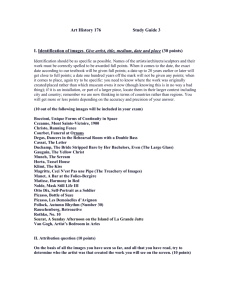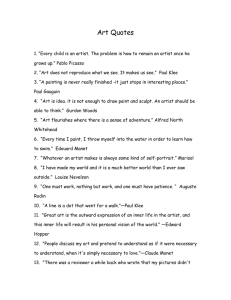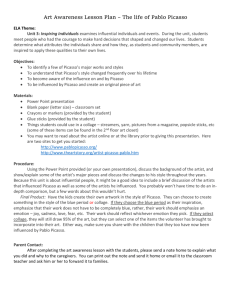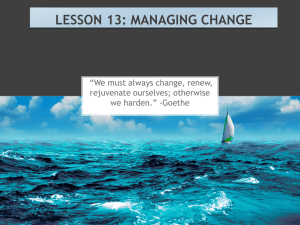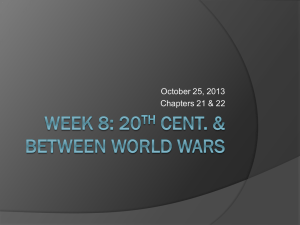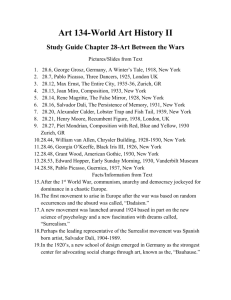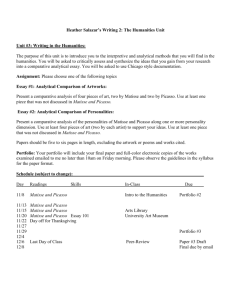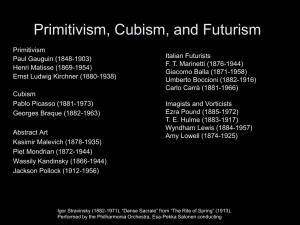The Starry Night
advertisement
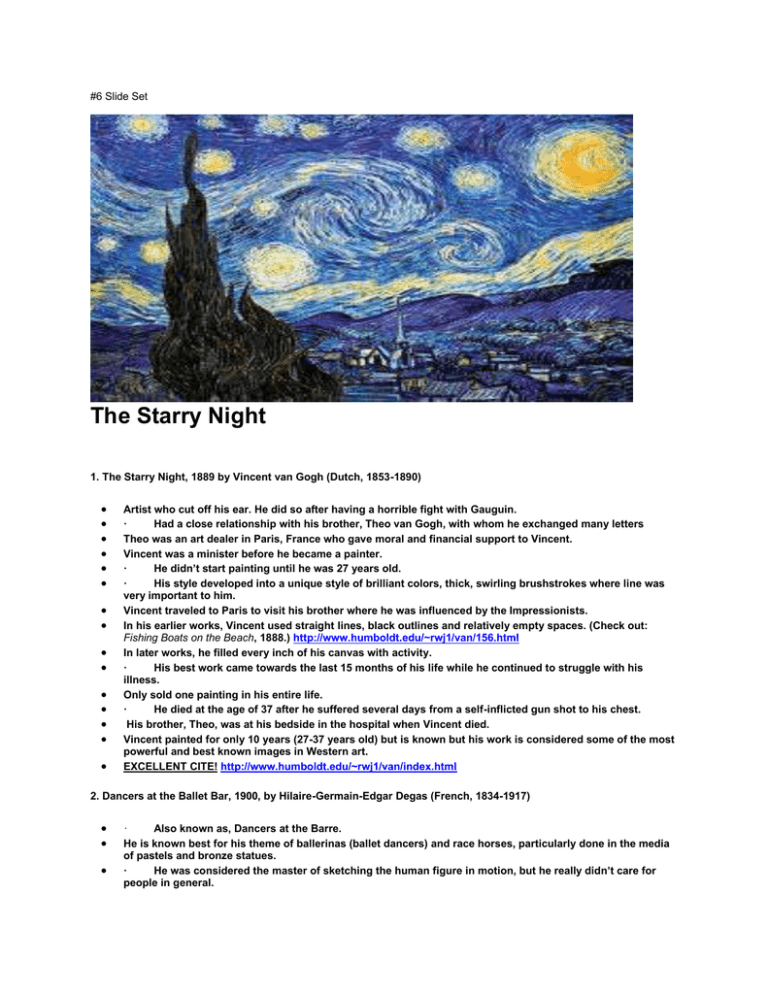
#6 Slide Set The Starry Night 1. The Starry Night, 1889 by Vincent van Gogh (Dutch, 1853-1890) Artist who cut off his ear. He did so after having a horrible fight with Gauguin. · Had a close relationship with his brother, Theo van Gogh, with whom he exchanged many letters Theo was an art dealer in Paris, France who gave moral and financial support to Vincent. Vincent was a minister before he became a painter. · He didn’t start painting until he was 27 years old. · His style developed into a unique style of brilliant colors, thick, swirling brushstrokes where line was very important to him. Vincent traveled to Paris to visit his brother where he was influenced by the Impressionists. In his earlier works, Vincent used straight lines, black outlines and relatively empty spaces. (Check out: Fishing Boats on the Beach, 1888.) http://www.humboldt.edu/~rwj1/van/156.html In later works, he filled every inch of his canvas with activity. · His best work came towards the last 15 months of his life while he continued to struggle with his illness. Only sold one painting in his entire life. · He died at the age of 37 after he suffered several days from a self-inflicted gun shot to his chest. His brother, Theo, was at his bedside in the hospital when Vincent died. Vincent painted for only 10 years (27-37 years old) but is known but his work is considered some of the most powerful and best known images in Western art. EXCELLENT CITE! http://www.humboldt.edu/~rwj1/van/index.html 2. Dancers at the Ballet Bar, 1900, by Hilaire-Germain-Edgar Degas (French, 1834-1917) · Also known as, Dancers at the Barre. He is known best for his theme of ballerinas (ballet dancers) and race horses, particularly done in the media of pastels and bronze statues. · He was considered the master of sketching the human figure in motion, but he really didn’t care for people in general. · He was influenced by Édouard Manet and exhibited his works with the other Impressionists. Check it out: Little 14 year old Dancer 1881, http://www.humboldt.edu/~rwj1/104h/096.html In 1872, Degas visited relatives in Louisiana, who were in the cotton business. Because of that visit, he painted The Cotton Exchange at New Orleans (finished 1873). It was his only picture to be acquired by a museum in his lifetime. Check it out: http://www.theartgallery.com.au/ArtEducation/greatartists/Degas/CottonExchange/ and also click on “paintings.” To see this painting online go to: http://www.phillipscollection.org/html/collect.html http://www.ibiblio.org/wm/paint/auth/degas/ 3. Quadrille…Moulin Rouge, 1892, by Henri Toulouse-Lautrec (French, 1864-1901) “If my legs had been a bit longer, I never would have become a painter.” He suffered from brittle bones disease and broke his legs when he was a teenager, which affected the way he grew. He looked like a freak, so he felt more at home with society’s misfits, that’s why he was comfortable, “blending in” at Moulin Rouge and its crazy nightlife. He was born into one of the oldest and wealthiest families in France. He was not able to attend school due to his handicaps, but studied and passed his exams. After that, he went to Paris in 1881 to study art and was impressed by the Impressionists. During the day, Toulouse-Lautrec painted. In the evenings, he “hung out” with his new friends, two of whom were Degas and van Gogh. Often Toulouse-Lautrec was seen at Moulin Rouge, which means “red windmill.” The Moulin Rouge was a dance hall/bar. It is a place that still exits in an area of Paris known for its “naughty nightlife”. Posters & ads in the papers were the only formal ways of advertising, so the owner of the Moulin Rouge asked Toulouse-Lautrec if he would design posters for advertising the Moulin Rouge and its entertainment. Toulouse-Lautrec did and now we can look back and see that his style of work in these posters is the basis of our modern day movie posters. The French government thought the subject matter of Toulouse-Lautrec was unfit for proper society to see and tried to keep it out of the public eye, especially after Toulouse-Lautrec died. http://www.simplytaty.com/history/moulinrouge.htm & http://www.nga.gov/search/index.shtm 4. Ia Orana Maria, 1891, by Paul Gauguin (French, 1848 - 1903) Ia Orana Maria means, “Hail Mary” or “We Greet Thee, Mary.” Oil on canvas; 44 3/4 x 34 1/2 in. “In this picture, painted during the artist's first trip to Tahiti (1891–93), Gauguin adapts the vernacular art and customs of the South Pacific to express a Christian theme. The title, in native dialect, is the angel Gabriel's greeting to the Virgin Mary at the Annunciation. The composition is based on a photograph of a bas-relief in the Javanese temple of Borobodur.” http://www.metmuseum.org/Works_Of_Art/viewOne.asp?dep=11&viewMode=0&item=51.112.2 He had ties to Peru (mom) and France (dad) and was born in Paris. He traveled A LOT! He eventually married, had a wife and 5 kids. He lost his job in the stock market crash in Paris, but lived on his inheritance from his grandparents in Peru. He worked the odd jobs, even work in Rouen. His wife eventually took the kids back to her home country of Denmark, where Gauguin couldn’t stand to live, so he left. “He left to pursue an independent life, though he remained in regular contact with his wife and children, largely by correspondence, for the rest of his life.” (http://www.nga.gov/cgi-bin/pbio?11750) “His final move to the Pacific Islands, with sporadic returns to Paris, began in 1891 with his transfer to Tahiti, as head of a government-funded artistic mission. He found his dream of an earthly paradise there severely compromised. As in Europe, he saw discord and a native culture overcome by Western values--including the need for capital to live. Nonetheless he produced prolifically, amidst quarrels with authorities, scandals, and relations with local women that yielded yet more children. Various illnesses, including syphilis, left Gauguin increasingly immobilized during his last years. He died in 1903 and remains buried on Atuona (Marquesas Islands).” (http://www.nga.gov/cgi-bin/pbio?11750) http://www.nga.gov/cgi-bin/psearch?Request=S&Name=gauguin&Title= Or http://www.nga.gov and type in Gauguin in the artists’ last name box and hit “search”. http://www.metmuseum.org/Works_Of_Art/viewOne.asp?dep=11&viewMode=0&item=51.112.2 5. The Voice, 1893 by Edvard Munch (Norwegian, 1863-1944) Another name for this painting is Summer Night’s Dream. It’s 34 5/8 x 42 ½ inches big. Oil on canvas. It’s about his 1st childhood romance where he had to stand on a hill to look into the eyes of a much taller girl. “Without fear and illness, I could never have accomplished all I have.” His dad was a doctor who saw the sick at home. His mom died when he was 5 and a sister died when he was 14 years old. He also suffered from ill health. He had some “disastrous love affairs, one somehow ending with the artist shooting off one of his fingers.” (Scholastic Art, Sept/Oct 1996, p.6) In 1885 he saw the Impressionists’ paintings. A few years later, his dad died and he turned away from the light influence of the Impressionist and wrote, “…I will paint living people who breathe and feel and suffer and love.” (Scholastic Art, Sept/Oct 1996, p.5) “Nature is not only all that is visible to the eye---it also includes the inner pictures of the soul.” (Scholastic Art, Sept/Oct 1996, p.4) “A gifted Norwegian painter and printmaker, Edvard Munch not only was his country's greatest artist, but also played a vital role in the development of German Expressionism. His work often included the symbolic portrayal of such themes as misery, sickness, and death.” (http://www.ibiblio.org/wm/paint/auth/munch/) His most famous art work is The Scream: ‘The extreme familiarity of this image today makes it hard to realize how shocking it and other works by Munch were when they were created slightly over a hundred years ago. Munch's art represented his own emotions, mostly the darker ones of fear, dread, loneliness, and sexual longing, with extraordinary expressiveness. The screaming figure personifies…horror. A precursor of this image is a drawing of a man (Munch himself) on a similar bridge, with a blood-red sky above. A text accompanying this drawing states: "I walked with two friends. Then the sun sank. Suddenly the sky turned as red as blood … My friends walked on, and I was left alone, trembling with fear. I felt as if all nature were filled with one mighty unending shriek."’ (http://www.metmuseum.org/toah/ho/10/eue/hod_1984.1203.1.htm) 6. The Tragedy, by Pablo Picasso, Spain (but he painted mostly in France) There is a lot of information here, but Picasso was thought by many to be THE most influential artist of the 20 th century. So here we go!!! Picasso and the Blue Period: Pablo Picasso is perhaps the most widely recognized and influential artist of the 20th century. In his early twenties, after he moved from Spain to France, the young Pablo Picasso began to tint his paintings a pale, cold blue, painting as if he is viewing the world through blue spectacles. Blue hues were chosen deliberately — deep and cold, signifying misery and despair — to intensify the hopelessness of the figures depicted, such as beggars, prostitutes, the blind, out-of-work actors and circus folk, as well as Picasso himself and his penniless friends. (At the time, Picasso even wore blue clothes.) Picasso’s “Blue Period” (around 1901-1903) is further triggered by the fate of his closest friend, whose infatuation with a girl and her rejection led to his subsequent attempt to kill her and to his own suicide. (Picasso explained later, “It was thinking about my friend that got me started painting in blue.”) The Blue Period dramatizes the artist as an outcast from society. Indeed, in Paris at that time, far from family and home, Picasso is unrecognized, unappreciated and in extreme poverty. His choice of subject matter was largely drawn from the hopelessness of the socio-economic underclass in Barcelona, Spain and Paris, France. (Remember, he was from Spain.) The Tragedy figure grouping is at the edge of the sea but what it really suggests is that they are outcasts of society, with a theme of loss, longing, and loneliness. The mystery, anti-naturalism (these people do NOT look natural), and uncertainness of Picasso’s early works suggest that the Blue Period is Picasso's version of Symbolism, painting things that cannot be put into words. More Facts About Picasso: Rose Period · Gradually, Picasso’s colors brighten, in what has somewhat misleadingly been termed the “Rose Period” (19041906). ‘Misleading’ or not, that’s what we are going to call it. · The Rose Period, sometimes referred to as the ‘circus period’, marked a distinct style shift in his art. · His focus was mainly on a different group of social outcasts – circus performers. · Similar to themes in his earlier Blue Period artwork, Picasso felt empathy for his new subjects – circus performers. They were paid to entertain, but really had no relevance or significance in society. · The sad clown would become an important figure in his paintings, and would continue to appear as a theme in future pieces. Clowns appeared happy on the outside, but were unable to show their true feelings. · This period also marked Picasso’s first of many romantic relationships…and I DO many MANY! · The color in his paintings also shifted – now featuring warmer, reddish and pink colors. The thick outlines of the Blue Period also disappeared. · Not only soft pinks, but blues, reds and greens complement these images. The emaciated figures became fuller. · The new color expresses warmth and life: o Picasso’s paintings are beginning to sell o He now has a studio, a lover and a life. o The two periods — the “Blue” and the “Rose” — form a transition between the art of his youth and the art of his maturity. Classical Period: Post World War I marked a noted return to a more conservative art form. During the time period, Picasso focused on more classical themes - bathers, centaurs and women in classical drapery. He relied on his knowledge of the human form, based on his early studies of Greek and Roman art. Many of these subjects were shown as massive, heavy and dense. He also used a strong contrast of light and dark. NOTE: He had more than just these three ‘periods’ of painting but these will enable you to carry on an intelligent conversation. Cubism Style In 1907, Picasso and Georges Braque introduce Cubism, where form no longer appears to follow the traditional rules of three-dimensional representation. The Blue and Rose periods remain popular because the human figure is not as distorted and unrecognizable as in Picasso’s Cubist work. · Some paintings were composed of tightly structured geometric shapes, limited to the primary colors of red, blue and yellow (see The Musicians). · He also started painting women as contorted, whose open mouths and teeth reveal a very emotional attitude. * Guernica, by Picasso (1937) · Guernica was created to be the mural centerpiece of the Spanish Pavilion of the 1937 World's Fair in Spain. · The piece is a striking protest of a fascist coup led by Francisco Franco, the driving force behind a massive Civil War between Franco and Spain's Republican forces. · On a dark day in April 1937, on behalf of Franco against the Spanish population, Nazi armed forces chose a small Basque town in northern Spain for massive bomb tests for over three hours. · It is estimated that over 1,600 people were killed in Guernica and the town burned for three days. · As photographs and news of the bombing of Guernica reach his home in Paris, Picasso found immediate inspiration for his mural. · Picasso delivered Guernica just three months later on a large canvas. Key elements include a woman holding her dead child, a large eye of God, a bull and a wounded horse. Clearly, it depicts struggle and the horrors of war and fighting. 7. The Red Studio, by Henri Matisse (French) Along with Picasso, Matisse is considered as one of the two foremost artists of the modern period. Picasso respected Matisse as much as he respected any other artist! Regardless, Matisse rejected cubism in order to develop his own ideas. Matisse became a leader of fauvism, delighting in vivid colors, often using primary colors. (Now think, you KNOW that many of the paintings you have studied thus far, do NOT have primary colors!) His style is called ‘fauve’ because of his exuberant, abstract, wild use of color. * Fauve means ‘wild beast’. Matisse used ‘wild colors’; therefore, the term ‘fauve’ was used because of the wild colors he used. Fauvism is a much freer and more expressive style of painting. Fauvism was a short-lived movement, but was a substantial influence on the Expressionism style. Fauvism grew out of Pointillism and Post-Impressionism, but is characterized by a more primitive and less naturalistic form of expression. (Paul Gauguin's style and his use of color were especially strong influences.) Pointillism: Seurat Post Impressionism: artists who created art at the same time, or after, as the Impressionist, who did NOT paint in the Impressionistic style but deserved recognition because their own styles were so outstanding. Now, back to Matisse… After the demise of fauvism, Matisse continued to use color to communicate his joy in bold pattern and striking ornamentation in his paintings. In his last years he also made brilliant paper cutouts and stencils. Today, many major art exhibits combine Picasso and Matisse. 8. Anna Zborowska, Modigliani Expressionist painter and sculptor Modigliani was a bohemian artist In stylistic terms, he was an oddity: contemporary with the Cubists, but not part of their movement. He was from Jewish family in Italy When he studied art in Venice, Italy, he had his first real introduction to the pleasures of drugs and drink. Heavy drinking ruined many of his relationships. There are clear signs in his work of influence from the art from Africa, due to his linear style and his elongated portraits and nudes, which attracted little praise from critics. He eventually moved to Paris, France, where many of his friends were mainly Jewish and he discovered a much stronger sense of Jewish identity. The Polish art dealer Mr. Zborowska took an interest in his work and thanks to Zborowski's efforts, Modigliani's paintings were at last starting to fetch respectable prices. (Anna, Mrs. Zborowska? Not sure.) However, he was still miserably poor - his sculpture was made mostly from stone stolen from building sites, easy to find as Paris was in a building boom. What stopped his carving, and led to the final phase in his work, was the outbreak of World War I, because this brought the building boom to an abrupt halt. By this time, Modigliani was no longer feeling strong enough for the hard physical labor of shaping blocks of stone. His perilous and reckless lifestyle created more attention from the public than his art, and ultimately caused his death from tuberculosis at the age of thirty-five. Devastated by his passing, his mistress and model, Jeanne Hebuterne killed herself the following day while carrying Modigliani’s child. 9. Brooklyn Bridge, by Joseph Stella, Italian immigrant to America On June 13, 1877, Giuseppe Michele Stella was born in a mountain village near Naples, Italy. At the age of 18, he arrived at Ellis Island and assimilated the English version of his name, Joseph Stella. After a year at medical school, followed by another year at pharmacy school, Joseph Stella found his true passion - the arts. · In 1903, artist Robert Henri became an instructor at the New York School of art. Once hearing Henri’s belief that no subject was too mundane for art, the young Stella soon turned to illustrating subjects of New York’s immigrant population to which he, himself, belonged. · Stella became involved in the immigration issues that were sweeping the nation, arguing for the equal treatment of fellow immigrants. · Inspired by his own immigration experience, Stella, an Italian native, sought to capture the grandeur of the Brooklyn Bridge and the magnificence of the Manhattan skyline that it revealed He created art for social reform weekly magazines. While working as an illustrator, Stella was also making a name for himself as a painter. However, despite success in America, Stella grew homesick and sailed to his small hometown in Italy. During his visit to Paris, he saw Cubist and Futurist works of art. Influenced by the Italian Futurists, Stella adopted the group’s claims that the modern artist should not look to the past for material; instead, the modern artist must try to express the civilization of his or her own era. Stella returned to New York and broke away from the traditional styles he had been taught years earlier, changing from traditional style to modern art. When looking back at the career of Joseph Stella, it is clear that the artist avoided allegiance to a single style. For the majority of his life, he alternated between a Surrealist style and an abstract, Futurist style. 10. I and the Village, Marc Chagall, Russian immigrant to America Marc Chagall was born July 7, 1887, in Russia, to a large family that lived in poverty; Still, he was very well educated. The Chagalls were devout Hassidic Jews, a factor that was very influential in his eventual artwork. If we are to learn about Mark Chagall and his art, we must look to his relationship with his childhood hometown. His work is rich in the imagery of the folklore of his native Russia and Jewish life, and often takes on the appearance of a dream-like fantasy. Against his parent's wishes Chagall decided that he wanted to be an artist. In 1910, he moved to Paris. We are sure of his devout relationship with his Jewish faith - numerous Chagall works draw on Jewish symbolism and reference Judaism, including stained-glass masterpieces like The Twelve Tribes of Israel (1960-62); Chagall visited Russia in 1914, and was prevented from returning to Paris by the outbreak of war. (Eventually, moved back to Paris.) Meanwhile the Nazi's were rapidly gaining power and ordered some of Chagall's work to be burnt. (Remember, he was Jewish.) During World War II, Chagall fled to the United States. He settled permanently in France in 1948 and he worked in painting and stained glass. · Throughout his artistic life he assimilated many of the modern developments in art into his own personal style. · Chagall's distinctive use of color and form is derived partly from Russian expressionism and French cubism. · He was influenced by, but never aligned to, movements such as Cubism, Fauvism and Surrealism. · In the early 1960's he was commissioned to create some stained-glass windows for the Hadassah University Medical Center, Jerusalem. This commission was of particular emotional significance for Chagall, touching the very heart of his relationship with his Jewish faith. "All the time I was working," he said, "I felt my father and my mother were looking over my shoulder, and behind them were Jews, millions of other vanished Jews of yesterday and a thousand years ago." · Many images of his childhood memories float through many of his works and works combine recollection with folklore and fantasy. · His heart was eternally connected to his childhood home in Russia, with nostalgic images of this small provincial ghetto in Russia as the backdrop to many of Chagall's best known works such as I and the Village. · The breadth of his abilities is shown in the fact that he was able to take on many challenges such as stainedglass, theatre and costume design and book illustration. · His numerous works represent characteristically vivid recollections of Russian-Jewish village scenes, as in I and the Village, and incidents in his private life. · I and the Village has an atmosphere of fantasy where dreamlike images seem to float above the ground, with unconventional space and perspective. · I and the Village shows that clearly, Cubist influences fracture the picture plane like a stained-glass window.

